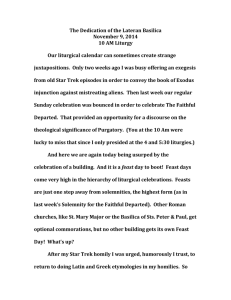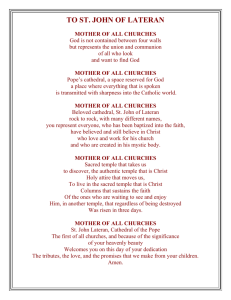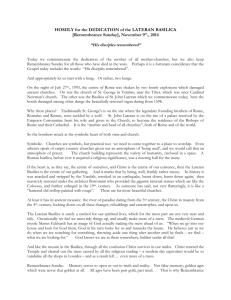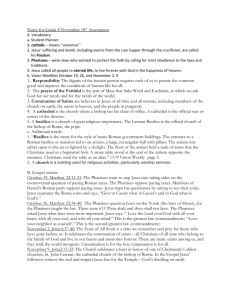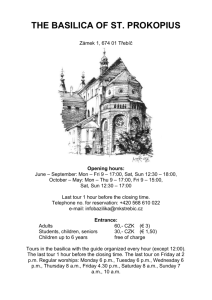Dedication-of-the-Basilica-of-St.-John-Lateran1
advertisement
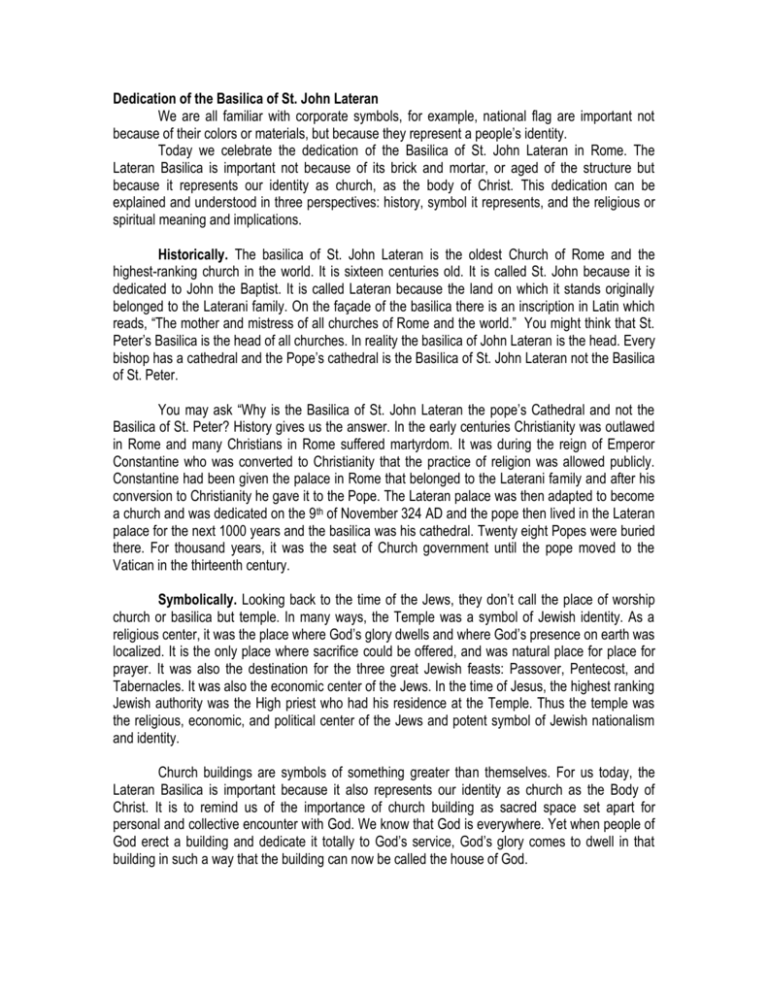
Dedication of the Basilica of St. John Lateran We are all familiar with corporate symbols, for example, national flag are important not because of their colors or materials, but because they represent a people’s identity. Today we celebrate the dedication of the Basilica of St. John Lateran in Rome. The Lateran Basilica is important not because of its brick and mortar, or aged of the structure but because it represents our identity as church, as the body of Christ. This dedication can be explained and understood in three perspectives: history, symbol it represents, and the religious or spiritual meaning and implications. Historically. The basilica of St. John Lateran is the oldest Church of Rome and the highest-ranking church in the world. It is sixteen centuries old. It is called St. John because it is dedicated to John the Baptist. It is called Lateran because the land on which it stands originally belonged to the Laterani family. On the façade of the basilica there is an inscription in Latin which reads, “The mother and mistress of all churches of Rome and the world.” You might think that St. Peter’s Basilica is the head of all churches. In reality the basilica of John Lateran is the head. Every bishop has a cathedral and the Pope’s cathedral is the Basilica of St. John Lateran not the Basilica of St. Peter. You may ask “Why is the Basilica of St. John Lateran the pope’s Cathedral and not the Basilica of St. Peter? History gives us the answer. In the early centuries Christianity was outlawed in Rome and many Christians in Rome suffered martyrdom. It was during the reign of Emperor Constantine who was converted to Christianity that the practice of religion was allowed publicly. Constantine had been given the palace in Rome that belonged to the Laterani family and after his conversion to Christianity he gave it to the Pope. The Lateran palace was then adapted to become a church and was dedicated on the 9th of November 324 AD and the pope then lived in the Lateran palace for the next 1000 years and the basilica was his cathedral. Twenty eight Popes were buried there. For thousand years, it was the seat of Church government until the pope moved to the Vatican in the thirteenth century. Symbolically. Looking back to the time of the Jews, they don’t call the place of worship church or basilica but temple. In many ways, the Temple was a symbol of Jewish identity. As a religious center, it was the place where God’s glory dwells and where God’s presence on earth was localized. It is the only place where sacrifice could be offered, and was natural place for place for prayer. It was also the destination for the three great Jewish feasts: Passover, Pentecost, and Tabernacles. It was also the economic center of the Jews. In the time of Jesus, the highest ranking Jewish authority was the High priest who had his residence at the Temple. Thus the temple was the religious, economic, and political center of the Jews and potent symbol of Jewish nationalism and identity. Church buildings are symbols of something greater than themselves. For us today, the Lateran Basilica is important because it also represents our identity as church as the Body of Christ. It is to remind us of the importance of church building as sacred space set apart for personal and collective encounter with God. We know that God is everywhere. Yet when people of God erect a building and dedicate it totally to God’s service, God’s glory comes to dwell in that building in such a way that the building can now be called the house of God. Solomon recalls this mystery in his prayer of dedication of the Temple of Jerusalem: “Even heaven and the highest heaven cannot contain you, much less this house that I have built.”(1 Kings 8:27). So, while we celebrate God’s special presence in the Temple or Basilica, we must remind ourselves that God’s presence is not confined in the temple or church. God still is everywhere. But God manifest His glory in a special way in some persons, places, and things. A temple or church is one such place. Celebrating the dedication of the Pope’s cathedral today shows our unity with the Pope and our love and respect for him. It shows also that we are united with each other in the Church. Religious or spiritual meaning and implications. In the vision of Ezekiel in our first reading, “all life comes from the water flowing from the Temple.” For us today, because Jesus is the living temple, all life flows from him. This vision of Ezekiel was affirmed in the Gospel today when Jesus refers to his body as the Temple (destroy this temple and in three days I will raise it up). In other words, Jesus embodies the religious purpose and significance of the Temple. Moreover, just as the temple was the meeting place for God and humanity, the church teaches that the body of Christ, the people of God is the Temple in which humanity and divinity dwell together completely. That’ is why Paul in the Second reading states that the real Church is made up of people. The connecting links over centuries are not buildings but people who transmit a life and a tradition. Without God and people who give them life, old temples or basilica and church will remain empty monuments robbed of all meaning. What can be said of Jesus also applies to disciples: Christians, who are collectively the Body of Christ, are also the “Temple of God.” And individually are “living stones….built into a spiritual house.”
